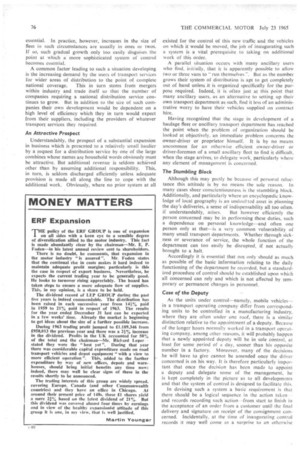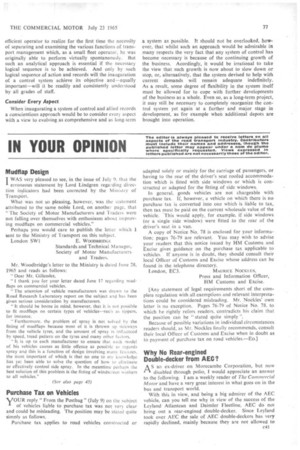ADVICE ON TRANSPORT PROBLEMS
Page 77

Page 78

Page 79

If you've noticed an error in this article please click here to report it so we can fix it.
Planned Control
PROBLEMS THAT FACE A GROWING HAULAGE BUSINESS
RECENT statistics have confirmed that the road transport industry is made up of relatively small units. This . fact has substantially contributed towards the industry's success through the flexibility of operation which has thereby resulted. • Such flexibility has been enhanced by the door-to-door service which only road vehicles can provide and the substantial technical advances in vehicle.reliability, economy and the ratio of load capacity to capital outlay.
However, whilst one readily identifies a small transport unit as an owner-driver or small fleet operator of four or fivevehicles it should not be overlooked that in other industries a unit. would still be considered small if it employed less than 100 persons. Admittedly, recent amalgamations and take-overs in public haulage, together with the increasing size of some ancillary transport departments, have resulted in several fleets of more than 1,000 vehicles. But despite these trends at the upper and lower limits of sizes of fleets it is pertinent to note that of 205.600 vehicles in public haulage, as recorded in a recent analysis published by the Ministry of Transport, 62,000 (or around 30 per cent) comprised fleets of 11 to 50 vehicles.
As just stated, a company with personnel limited to little more than the number of vehicles in such fleets would be considered small by general industrial standards. But because of the inherent mobility of the road vehicle, control of operation of even this size of fleet presents special problems.
Although this Ministry analysis is limited to enumerating the respective size of haulage fleets, it is inevitable that the sizes chosen are to some extent arbitrary and if considered in isolation might imply a separate entity: In fact, it would be a fair assumption that the great majority of these arbitrary sizes had arisen from natural developments over the years. In contrast, the number of operators setting up in business with, say, 50 vehicles from the outset, must be relatively small. In many other industries the setting up of a sizeable organization from the start would not be quite such an exception even though gradual developments may still apply.
Problems at Certain Stages
Because of this dissimilarity, transport operators can be confronted with problems of control at certain stages of development which would not commonly occur in other industries. Where an operator sets up in a haulage business• as an owner-driver with or without a few additional vehicles, or alternatively where an ancillary user—for example a retailer—finds it convenient to run his own van, the problems of control seem virtually non-existent. Functionally this is a fallacy, but because every decision is made on the spot by usually one man, and in many cases the resulting orders are -executed by the same man, then the term " control " seems little more than academic.
The opportunity for immediate action which is therebymade possible provides an excellent contribution to efficient operation to the satisfaction of the customer. 'Even when additional vehicles in relatively small numbers are added. it is still possible for a capable operator to rnanage.successfully largely on the basis of Memory and verbal instruction with little or no semblance of a planned control system. Indeed, if such did exist at this relatively early stage of development, it might justifiably be considered as unnecessary paper work.
Rule of Thumb' Methods Unfortunately the very success of a small haulage business or ancillary department operating largely, though ethcietilly, on " rule of thumb methods may well mislead the operators concerned as to the limitations of such a procedure. Looking at this problem objectively it becomes obvious that somewhere along the line there must be a limit to what can be done by memory and verbal instruction, after which a planned system of control becomes essential. In practice, however, increases in the size of fleet in such circumstances are usually in ones or twos. If so, such gradual growth only too easily disguises the point at which a. more sophisticated system of control becomes essential.
A common factor leading to such a situation developing is the increasing demand by the users of transport services for wider areas of distribution to the point of complete national coverage. This in turn stems from mergers within industry and trade itself so that the number of companies requiring a national distribution service continues to grow. • But in addition to the size of such companies their own development would be dependent on a high level of efficiency which they in turn would expect from their suppliers, including the providers of whatever transport services they required.
An Attractive Prospect Understandably, the prospect of a substantial expansion in business which is presented to a relatively small haulier by a request for a distribution service by one of the large combines whose names are household words obviously must be attractive. But additional revenue is seldom achieved other than by assuming additional responsibility. This, in turn, is seldom discharged efficiently unless adequate provision is made all along the line to cope with the additional work. Obviously, where no prior system at all
existed for the control of this new traffic and the vehicles on which it would be moved, the job of inaugurating such a system is a vital prerequisite to taking on additional work of this order.
A parallel situation occurs with 'many ancillary users who find, initially, that it is apparently possible to allow two or three vans to " run themselves ". But as the number grows their system of distribution is apt to get completely out of hand unless. it is organized specifically for the purpose required. Indeed, it is often just at this point that many ancillary users, as an alternative to setting up their own transport department as such, find it less of an administrative worry to have their vehicles supplied on contract hire.
Having recognized that the stage in development of a haulage fleet or ancillary transport department has reached the point when the problem of organization should be looked at objectively, an immediate problem concerns the owner-driver or proprietor himself. It is by no means uncommon for an otherwise efficient owner-driver or driver-foreman of a small ancillary fleet to find it difficult, when the stage arrives, to delegate work, particularly where any element of management is concerned.
The Stumbling Block
Although this may partly be because of personal reluctance this attitude is by no means the sole reason. In many cases sheer conscientiousness is the stumbling block. Additionally, and particularly where an encyclopmdic knowledge of local geography is an undouFted asset in planning the day's deliveries, a sense of indispensability all too often.
if understandably, arises. But however efficiently the person concerned may be in performing these duties, such a dependence on personal knowledge—and often one person only at that—is a very common vulnerability of many small transport departments. Whether through sickness or severance of service, the whole function of the department can too easily be disrupted, if not actually brought to a halt.
Accordingly it is essential that not only should as much as possible of the basic information relating to the daily functioning of the department be recorded, but a standardized procedure of control should be established upon which all concerned can rely and which is not affected by temporary or permanent changes in personnel.
Case of the Deputy
As the units under control—namely, mobile vehicles— in a transport operating company differ from corresponding units to be controlled in a manufacturing industry, where they are often under one roof, there is a similar distinction relative to the appointment of a deputy. Because of the longer hours normally worked in a transport operating company, among other reasons, it will probably happen that a newly appointed deputy will be in sole control, at least for some period of a day, sooner than his opposite number in a factory. Moreover, many of the decisions he will have to give cannot be amended once the driver concerned is on his way. It is therefore particularly important that once the decision has been made to appoint a deputy and delegate some of the management, he is kept completely in the picture as to all developments and that the system of control is designed to facilitate this.
In devising such a system a basic requirement is that there should be a logical sequence in the action taken and records recording such action -from start to finish in the acceptance of an order from a customer until the final delivery and signature on receipt of the consignment concerned. Incidentally, at the time of inaugurating control records it may well come as a surprise to an otherwise efficient operator to realize for the first time the necessity of separating and examining the various functions of transport management which, as a small fleet operator, he was originally able to perform virtually spontaneously. But such an analytical approach is essential if the necessary logical sequence is to be achieved. And only by such logical sequence of action and records will the inauguration of a control system achieve its objective and—equally important—will it be readily and consistently understood by all grades of staff.
Consider Every Aspect
When inaugurating a system of control and allied records a conscientious approach would be to consider every aspect with a view to evolving as comprehensive and as long-term
a system as possible. It should not be overlooked, however, that whilst such an approach would be admirable in many respects the very fact that any system of control has become necessary is because of the continuing growth of the business. Acordingly, it would be irrational to take the view that such growth is now about to slow down or stop, or, alternatively, that the system devised to help with current demands will remain adequate indefinitely. As a result, some degree of flexibility in the system itself must be allowed for to cope with further developments of the business as a whole. Even so, as a long-term project, it may still be necessary to completely reorganize the control system yet again at a further and major stage in development, as for example whet additional depots are brought into operation.




























































































































